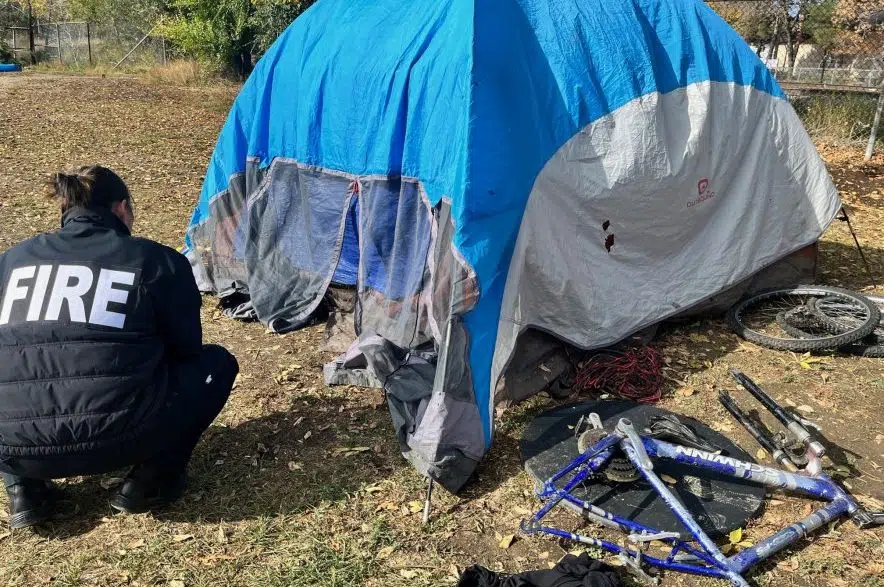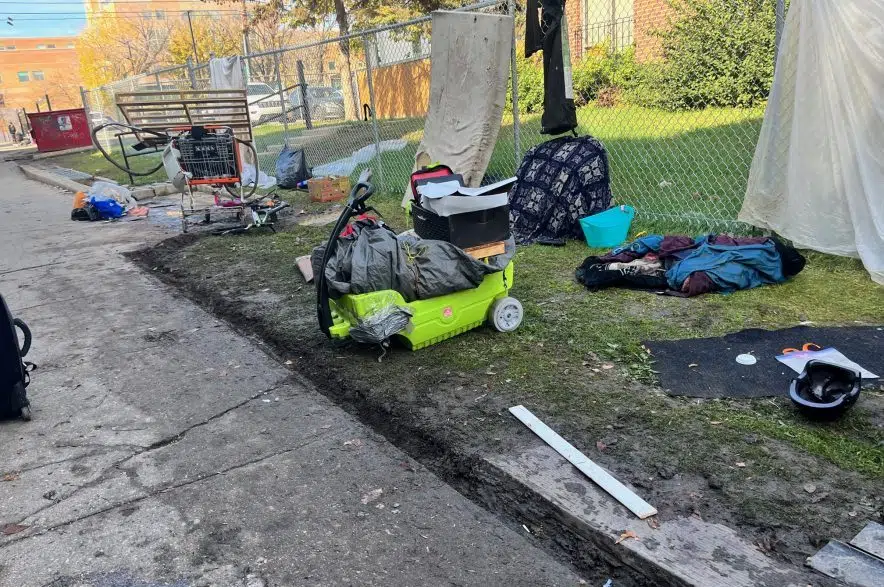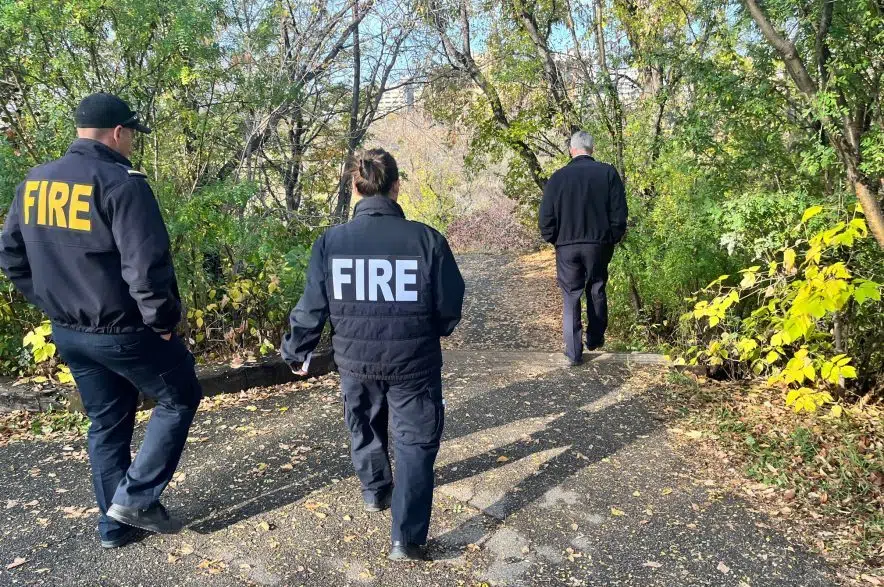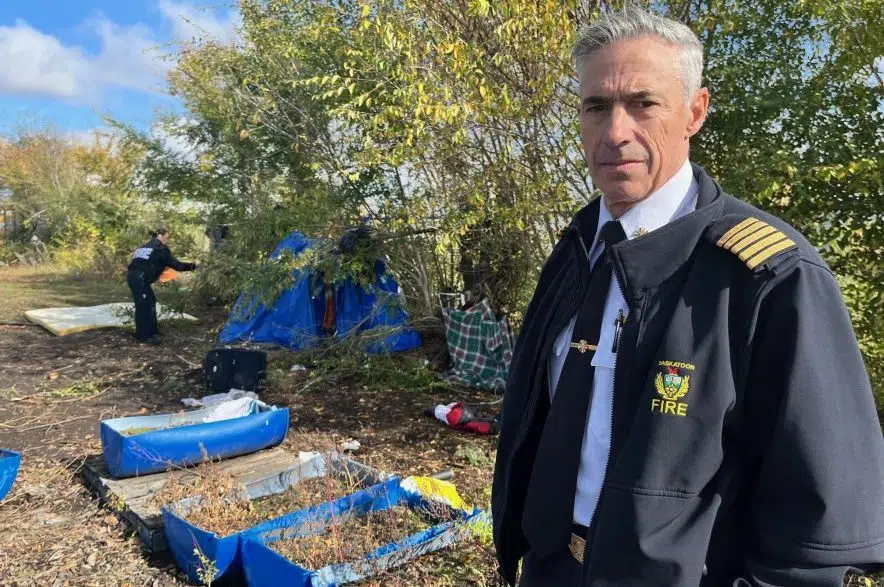Amid mud and leaves at a community garden near the railroad tracks in Pleasant Hill, a Saskatoon Fire Department inspector crouches at the opening of a small blue tent.
“Fire department. How’s it going? Who am I talking to?” she asks.
The tent is one of four set up around the dying garden’s perimeter on a brisk October morning. A tarp over one of the tents reads “There’s a champion in here.”
Dawn, the inspector, asks the person inside if they are OK. A weak voice replies that his name is “Eddie” and that he is sick.
“Do you need the hospital? Need an ambulance or anything?” she inquires.
650 CKOM is not using the last names of Dawn, or her colleague Terry, for safety reasons. The fire department duo responds to daily complaints about hundreds of homeless people at encampments across the city, but their work is complicated and involves connecting those living in makeshift shelters with social services or resources to help them return to a home.
Homeless encampments are a growing concern, and occupy most neighbourhoods in Saskatoon, including Churchill, Avalon, Evergreen and Stonebridge.
In 2022, the fire department counted 512 interactions with people who were unhoused and living in temporary structures throughout the city. As of August this year, that number had climbed to nearly 600.
Fire Chief Morgan Hackl estimates that 85 per cent of neighbourhoods in the city have someone unhoused living in them.
“Our data is still climbing, and that’s concerning to us,” he says.

A Saskatoon fire department inspector approaches a tent in a Pleasant Hill community garden to inquire if the occupant needs help. (Lara Fominoff/650 CKOM)
650 CKOM senior reporter Lara Fominoff was permitted to ride along with the fire department as the inspectors visited notable spots where encampments often form. The community garden in Pleasant Hill was one of those places.
“Have I met you before?” Dawn persists. “Are you sure there isn’t something we can do for you?”
Eddie remains in his tent as Dawn hands him an Emergency Notice to Remedy, which informs the tent occupants the structure isn’t safe and must be taken down. It was the second time in just a few days the notices had been handed out.
Building relationships
Another area where encampments are regularly found and dismantled is the alley behind Prairie Harm Reduction and St. Mary’s Parish, located next door.
A bright green wagon with a missing wheel, piles of clothing and a discarded bike helmet line the fence. A stained mattress is propped against the chain-link fence while a draped sheet hangs nearby.
“Quite often, there would be structures along the fence (behind the church), in the back yard of one property … a couple by Prairie Harm,” Hackl points out.
Hackl and Terry, the inspector, are well known in the area, stopping to speak with several people seated along a concrete wall who say they’d either been on the Saskatchewan Assured Income for Disability program or wanted help getting lost or stolen government-issued ID replaced.
“We have a good relationship. I know how you treat me,” Hackl says to one man who approaches him.
“And you know how I treat you,” he continues. “You know if you need anything when you see our staff, they’ll help you out, right?”
But not everyone in the area is receptive to Hackl and Terry being there. One man who rides into the crowd on a bicycle makes his way from person to person, appearing to either give or offer them something.
Suddenly, he puts on a green medical mask and faces the inspectors with both hands in his pockets.
“Hey, fireman! Here!” he yells while suddenly pulling a hand out of his pocket to throw something in their direction.
Terry and Hackl agree it’s time to wrap up their time at this location.
“We’ll do this quick, and then we’ll get out of here,” Terry says.

Belongings scattered in a church parking lot near Prairie Harm Reduction in Saskatoon on Oct. 3, 2023. (Lara Fominoff/650 CKOM)
A complicated issue
Along Saskatchewan Crescent East, a prestigious part of town lined with multi-million-dollar homes, Dawn receives a complaint about an encampment in Cosmopolitan Park.
A woman walking her dog sees the inspectors and says her sister called in the complaint.
“They’re pretty violent. They’ve broken in or attempted to break into my house,” she tells them.
“My garage was broken into, $7,500 damage to my car. I have no tolerance. I’m on a special calling list. Anytime I see anything, I call you guys. I’m sorry, but it’s dangerous,” she adds.
While there are dangers on the job, Dawn says the fire department makes a difference with many people she, Terry and Hackl have formed relationships with over the years.
“I actually love interacting with them. I really do. (I love) hearing their stories and trying to see what you can do to help. And (if) you even help one person, you get one person into a shelter, and you feel success,” she says.
But solving or even making a dent in the number of those who don’t have a home in Saskatoon is a complicated issue. Many people have addictions, intergenerational trauma, or mental health struggles. Some have very complex needs that are difficult to address, says Hackl.

Saskatoon Fire Chief Morgan Hackl (right) navigates the river valley trails with two inspectors as they aim to assess a known encampment site. (Lara Fominoff/650 CKOM)
About 40 per cent of the time, Hackl says, the fire department can help someone get into a shelter or connect them with a social assistance program.
“If we weren’t in this work, there would be a lot of people we believe that would not be connecting to services and supports,” he says.
“In a perfect world, we would have immediate supports, right? So we don’t have that. All of these things compound the problem. It’s not one agency. It’s so complicated that you can’t point to one thing.”
But as the days grow shorter and the temperature nears freezing, Hackl and his team aim to get as many people off the streets before winter arrives.











